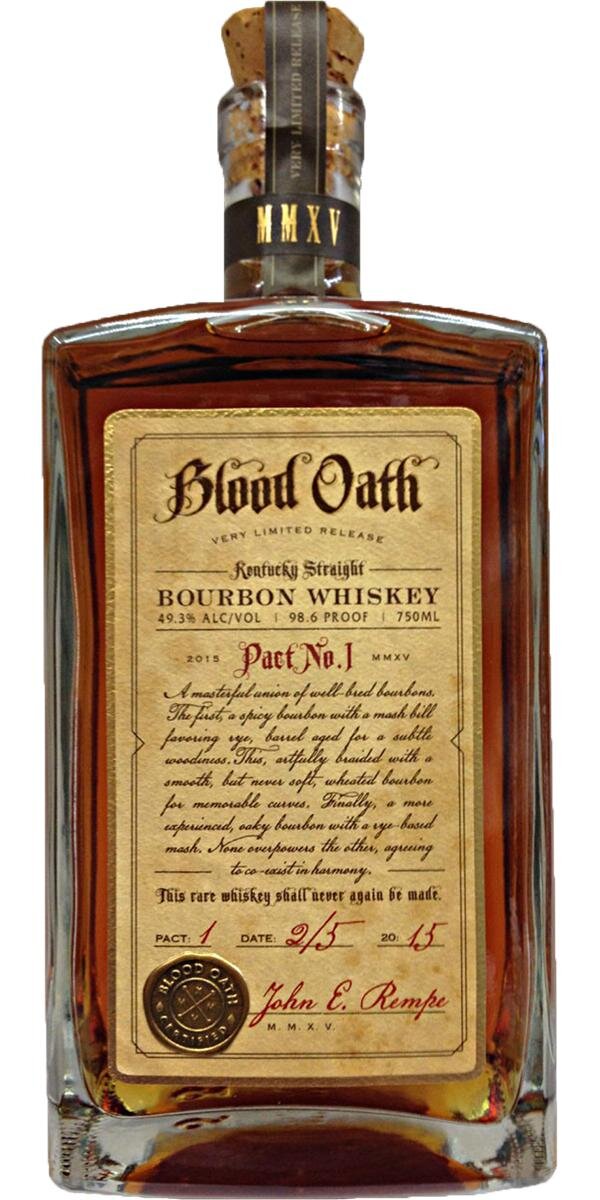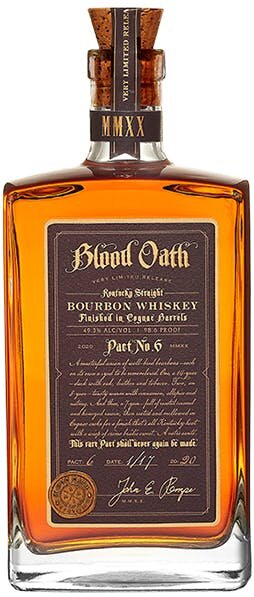Blood Oath Bourbon: Reinventing American Blended Whiskey
Starting in 2015, Lux Row Master Blender John Rempe started producing a brand new line of bourbons - Blood Oath Bourbon. Every batch - or Pact - is a blend of 2-3 bourbons. Sometimes one is finished, sometimes the final blend is finished, and every Pact is proofed down to 98.6º.
To me, regardless of each pact’s differentiating factor, the most fascinating part of the story is the blend. For decades - if not a century - the word “blend” was anathema in American whiskey. Blend meant cheap, imported (from Scotland and Canada in particular), lower grade, and, at the logical extreme, not pure.
Blend = a four-letter word
But why? Looking back to the 19th century, drinking whiskey in America was, well, a gamble. Some distillers and producers were putting out what we would think of as quality bourbon and rye, aged a few years (probably not beyond 3-4 years at that time since few had the funds to hold the liquid that long), and might still be considered bourbon or rye today. But, just as many if not more were putting out crappy liquid that was adulterated in some way.
These producers - called rectifiers - put any number of chemicals, additives, and bodily fluids (we’ll get to that) into their “whiskey” to make it at least look like whiskey if not taste like it. On the safer end, they might add prune juice and/or caramel coloring for color and possibly neutral grain spirit to dilute the whiskey and dilute their costs. On the less-safe side, some rectifiers added formaldehyde, kept too much of the distillate heads in (including methanol, the source of the “moonshine makes you blind” story), or even added tobacco spit. Remember I told you bodily fluids were involved? Well, yes, there could have been worse ones, but I’m still fine not having tobacco spit in my whiskey.
So what made this rectification stop? Well, nothing really, for awhile at least. The first step was the Bottled-in-Bond Act of 1897, the US’s first consumer protection law. Championed by bourbon legend Col. Edmund Haynes Taylor (E. H. Taylor), the Bottled-in-Bond Act (BIBA) laid down rules that allowed for government-sanctioned tax strips on bottles and safety/purity standards. Most whiskey at that time was being sold at between 80-100 proof maximum unless you were drinking moonshine, so putting the BIB standard at 100 US proof was a smart move.
Any American whiskey can be bottled-in-bond, as long as it follows all of these rules:
The product of one distillation season, from either January to June (Spring) or July to December (Fall)
Aged in a government-bonded warehouse for at least four years*
Bottled at 100 proof (U.S.)
Include the distillery at which it was made and bottled on the label
*Today, all legal warehouses are government-bonded, but at the time of the BIBA it was a new rule. Some will leave the government-bonded phrase out of the requirements nowadays because all the warehouses fall under that aegis.
In honor of Col. E. H. Taylor, Sazerac - the company that owns Buffalo Trace and puts out that line of whiskey - hosts a simple, easy-to-understand site all about being bottled-in-bond. We celebrate bottled-in-bond every year on March 3rd.
Later legislation such as the Concurrent Resolution of 1964 defining bourbon (and other American whiskies) in law built upon the BIBA, adding new delimitations to what could or couldn’t be called whiskey, bourbon, and more. A side effect of this, however, was to keep blends as an under-appreciated, even undesirable category of whiskey.
Blood Oath and the Blend
But anyway, back to Blood Oath. When John Rempe decided to start blending bourbons into this new product line, he must have wondered if a blended American whiskey - a blended bourbon no less - would be accepted into the market. Some other brands had tried, always putting out blends under euphemisms and synonyms - a “marriage of whiskies”, “perfectly mixed”, “brought together”. I would love to ask him about what he was thinking back then and how the outlook for blended bourbon looks now.
Of course, the key to any of this is that the blend had to be good, and Rempe set the tone with Blood Oath Pact 1. Subsequent pacts had an element added - a port finish, toasted bourbon barrels - but Pact 1 is just the blend, nothing to hide behind. And it is indeed a great blend. It wasn’t until Pact 4 that age statements were added, so I don’t know what the component ages were for this blend. All I can say is that they work harmoniously to create a well-rounded, flavorful bourbon with a fantastic mouthfeel (something that is pretty consistent among all pacts).
Throughout the six pacts I tried, I was struck by the blending each time. Not every finish or added factor jibed with my palate, but each blend underneath was exceptional. I’m a big fan of blended Scotches and Japanese whiskies (Canada, not as much) and I couldn’t help thinking about blenders like Stephanie MacLeod at Dewar’s or Jim Beveridge at Johnnie Walker - masters at their craft who can blend a dozen or more whiskies into a perfectly consistent product.
If American blended whiskies (bourbon or otherwise) are to rise again and compete with blended whiskies from around the world, Mr. Rempe and Lux Row have to be considered at the front of the line. I can’t wait to try Pact 7, and I can’t wait to hopefully speak to Mr. Rempe one day and ask him all about the art of the blend.
Blood Oath Pact 1
The original - a blend with nothing to hide behind.
Blood Oath Pact 2
The first twist: a port-finished component adds fruit to the party.
Blood Oath Pact 3
A Cabernet Sauvignon finish for a dark, fruity bourbon.
Blood Oath Pact 4
The first with age statements and a toasted barrel finish.
Blood Oath Pact 5
A Caribbean rum finish, but where in the Caribbean?
Blood Oath Pact 6
Finishing the entire blend in Cognac barrels - an interesting idea?










